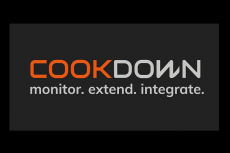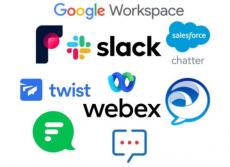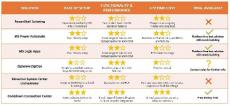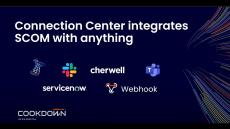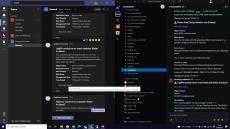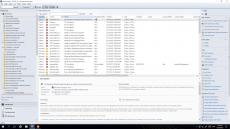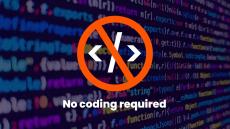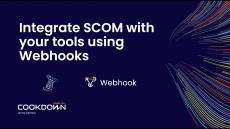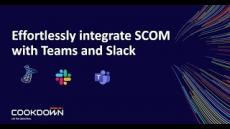|
By Charlotte Wyld
When we were setting SCOM 2022 Teams integration in our environment these are some of the issues and fixes we discovered. For the full setup guide for SCOM 2022, or if you are looking for integrations for older versions of SCOM (2012 R2+) or more functionality, such as bi-directional sync, check out our blog on ‘How does SCOM 2022’s native Microsoft Teams Integration Work?’
|
By Charlotte Wyld
Possibly the most anticipated feature of SCOM 2022 is Delegated Administrators! It’s not the shiniest of features but it has long been a pain point of SCOM admins, which have only ever been able to use three pre-defined roles to grant to users (plus read only). In SCOM 2022 you now have the ability to create Delegated Administrators, which overcomes some of the pain points previously felt with rigid roles and permissions.
|
By Charlotte Wyld
Good news! SCOM 2022 contains a native integration with Microsoft Teams, replacing the old Skype for Business integration! Once setup, you can expect notifications like the below one in Microsoft Teams channels as desired.
|
By Charlotte Wyld
If you’re a SCOM Admin these are the questions you should be asking yourself when it comes to measuring your monitoring success! So, here’s how to tackle these challenges and get the best out of SCOM.
|
By Charlotte Wyld
In today’s monitoring world most SCOM admins are pulling data from a range of tools and applications, as well as cloud platforms. It can be difficult to sift through all this data, let alone distill it down into a useful format. SCOM is a great resource for making this happen, and if it’s done well can be a superb monitoring hub for your other applications. But how do you get SCOM to consume data from other sources?
|
By Charlotte Wyld
Many organizations aspire to a world where everything is in the cloud. But, in reality most IT enterprises still rely on traditional on-prem monitoring technologies. As a market-leading monitoring tool, SCOM is ideally placed for the job; monitoring both on-prem workloads or workloads that link up to the cloud. So, as SCOM is central to most companies’ monitoring, it is essential you understand how to be successful with SCOM!
|
By Charlotte Wyld
A Webhook is an API that delivers data from applications when an action or event occurs. When an event is triggered within the source site, it is seen by the Webhook, which collects the data and sends it to the desired application or URL in the form of an HTTP request. Webhooks are also instant, triggering the delivery of data in real-time, this makes them faster and easier to implement than other methods, like polling.
|
By Charlotte Wyld
If you’re looking to integrate SCOM with your other IT applications your main drivers are probably centered around; increasing efficiency, improving stakeholder engagement, and smashing your incident response times!
|
By Charlotte Wyld
While SCOM is a valuable monitoring tool, you may also be using a suite of monitoring tools, such as SolarWinds to monitor network devices, VROps to monitor VMware, and Nagios to monitor your Linux devices, as all these tools are best in class. But, you don’t want to be looking in numerous different consoles to gather all your monitoring data!
|
By Charlotte Wyld
Bi-directional sync enables data to be sent to and from SCOM and your ITSM tools, in the following ways: a) OUTBOUND Notifications (PUSHES alerts from SCOM to another tool) b) INBOUND Notifications (PULLS updates on alerts into SCOM from another tool) This means you can choose which SCOM alerts to send across to your ITSM tools (Cherwell or ServiceNow), they are then raised as incidents, and then using bi-directional sync, info relating to the incidents is pulled back into SCOM (Incident ID, Configurat
|
By Cookdown
Keep your ITOps even better connected with the latest version of Connection Center! This deep dive illustrates exactly how Cookdown Connection Center can integrate SCOM with anything, anywhere….! We simply use Webhooks to convert critical SCOM alerts into actionable notifications in real time.
|
By Cookdown
Keep your ITOps even better connected with the latest version of Connection Center! Check out our release webinar for a tour of the new Webhook-enhanced features and much more.
|
By Cookdown
Cookdown's Connection Center is designed to make SCOM your single source of truth. Find out all about how it works, our code-free integrations, and much more. Unlock SCOMs full potential by connecting it to all your IT enterprise tools and you'll never miss a critical SCOM alert again! The setup is super simple! To get started just download a FREE 30-DAY TRIAL and you'll be syncing alerts in minutes.
|
By Cookdown
A deep dive into Cookdown's Connection Center is designed to make SCOM your single source of truth. Find out all about how it works, our code-free integrations, and much more. Unlock SCOMs full potential by connecting it to all your IT enterprise tools and you'll never miss a critical SCOM alert again! The setup is super simple! To get started just download a FREE 30-DAY TRIAL and you'll be syncing alerts in minutes.
|
By Cookdown
Cookdown's Connection Center for Webhooks Outbound provides everything you need to get SCOM working in unison with your enterprise IT tools. In this video discover how we send Alerts from SCOM and push them into other platforms as incidents, messages & tickets, to trigger automations.
|
By Cookdown
This short demo illustrates how Cookdown Connection Center can integrate SCOM with anything, anywhere….! We simply use Webhooks to convert critical SCOM alerts into actionable notifications in real-time. So, now you can push alerts from SCOM to any application supporting Webhooks, which means your team can view alerts in their favorite tools. Find out how Connection Center can get your stakeholders more engaged and better connected!
|
By Cookdown
This deep dive illustrates exactly how Cookdown Connection Center can integrate SCOM with anything, anywhere….! We simply use Webhooks to convert critical SCOM alerts into actionable notifications in real-time. So, now you can push alerts from SCOM to any application supporting Webhooks, which means your team can view alerts in their favorite tools. Find out how Connection Center can get your stakeholders more engaged and better connected!
|
By Cookdown
The release of our Connection Center for Webhooks Inbound means SCOM can now become a Webhook listener, enabling it to automatically receive data, and raise what it receives as SCOM alerts and events. This webinar takes you through all the new features of our latest integration for Inbound Webhooks and showcases how you can use it to make SCOM your central monitoring resource.
|
By Cookdown
In this webinar, we demonstrate how our latest product, Connection Center, uses Webhooks to seamlessly integrate SCOM with any of your other IT tools. Now you can integrate SCOM with anything using Webhooks. Our SCOM integrations are 100% code-free, meaning you can make your SCOM alerts truly actionable using real-time synchronization. We'll demonstrate the simple setup process, our plug and play integrations mean it only takes a matter of minutes to get SCOM working in unison with your enterprise applications,.
|
By Cookdown
See how easy it is to connect SCOM to Teams and Slack with Cookdown Connection Center in this webinar recording originally aired 26-Aug-2021. The Teams and Slack integrations demoed here are part of Cookdown Connection Center, your one-stop-shop for all your integration needs to and from SCOM without writing a line of code. Connection Center lets you raise Alerts in SCOM from anywhere and push alerts to ITSM platforms, notifications tools, and more.
- October 2022 (2)
- March 2022 (3)
- January 2022 (2)
- December 2021 (7)
- October 2021 (1)
- September 2021 (5)
- August 2021 (1)
- July 2021 (2)
- June 2021 (8)
- May 2021 (2)
- April 2021 (1)
- March 2021 (5)
- February 2021 (4)
- January 2021 (5)
- December 2020 (6)
- November 2020 (4)
- October 2020 (7)
- September 2020 (5)
- August 2020 (2)
- July 2020 (10)
- June 2020 (2)
- May 2020 (5)
- April 2020 (7)
- March 2020 (2)
- February 2020 (2)
- December 2019 (3)
- November 2019 (1)
- September 2019 (5)
- August 2019 (3)
- June 2019 (1)
- May 2019 (3)
- April 2019 (2)
- March 2019 (4)
Enrich your ServiceNow deployment with direct integrations with Microsoft SCOM. Our solutions are fast and easy to deploy, offer seamless integration, and can be fully customized to suit your needs.
ServiceNow Connector features:
- Alerts: Send filtered SCOM alerts to ServiceNow to create incidents, and keep both systems up-to-date using bi-directional syncing. View all Alerts directly in ServiceNow.
- Discovery: Populate ServiceNow’s CMDB with discovery data from SCOM, such as Windows and Linux servers, databases, clusters and more.
- Service Mapping: Leverage your SCOM agents to automatically map your applications. Nothing to deploy and configure – just fast, accurate service mapping.
Optimize your IT with Microsoft SCOM and ServiceNow.


